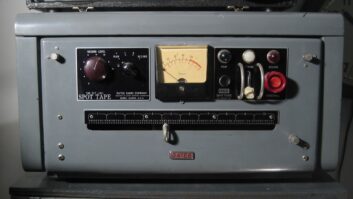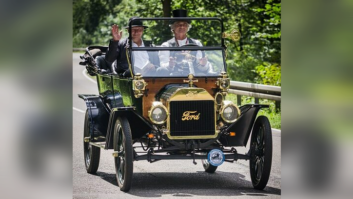
Afternoon women’s adult education group in Zambia gets lessons delivered by a Prime Radio.
LONDON — As radios go, Lifeline Energy’s Prime Radio seems overly big and bulky. It’s about the size and weight of a two-liter milk container, albeit housed in a bright blue case with large LED display, color-coded controls and a heft carrying handle.
There’s a good reason for the Prime Radio’s bulk: it is a combination solar/wind-up radio designed for impoverished developing communities where AC power is hard to find, and DC batteries are too expensive for people struggling to stay alive.
Access to education
The Prime Radio is the second-generation model of this receiver, which is made by the United Kingdom’s Lifeline Energy (formerly the Freeplay Foundation). It is a charitable foundation launched by Freeplay Energy founder Rory Stear and his wife Kristine Pearson in 1999.
Pearson has been Lifeline Energy’s CEO from the outset. Under her guidance, more than half a million solar/wind-up Lifeline radios have been built and distributed in Africa and Asia. Lifeline estimates that these radios are providing access to education and information for up to 20 million people.
“Since we began distributing wind-up radios in Rwanda back in 1999, our goal has remained constant,” said Pearson. “We want to provide orphans and child-headed households — of which there are too many in Africa due to the ongoing AIDS epidemic — with reliable connections to radio-borne education about health, day-to-day living skills and literacy skills.”
From the outset, Lifeline’s radios have been designed for the environment. The case is meant to be rugged, with the ability to replace the antenna using a coat hangar or whatever length of scrap wire might be at hand. The controls are color-coded for easy use because many of the people given these radios are unfamiliar with radio technology. Meanwhile, the Lifeline radio comes with a durable, large loudspeaker with the ability to project the radio’s audio in a big space.
“We have always envisioned the Lifeline being used in groups, for distance education classes,” Pearson said. “So the unit has to be able to serve this capacity. Meanwhile, the reason it has a large handle is because many of the girls who receive it work as farmers and take their radios into the field with them.”
What about the color? The reason that Lifeline radios are available in either blue or green is because their users find these colors comforting and cheerful. Also, black radios become too hot to carry when exposed to strong sunlight.
The second-generation Prime Radio has updated the original design by replacing the original mechanical tuning display with an LED screen.
Innovation

Children in a classroom in Kenya listen to the Lifeplayer MP3. Equipped with FM, AM and three SW bands, the Prime Radio can be powered by a solar panel (stored in the back of the radio’s case), its onboard hand-cranked battery charger (based on Freeplay’s original design), or a DC input that can connect to a car battery or, when available, AC mains power. The solar panel comes with a USB port option that can be used to charge cellphones.
The Prime Radio was borne out of Lifeline’s solar-powered MP3 player, which is known as the Lifeplayer. Capable of holding 64 GB of pre-loaded educational/informational content, the Lifeplayer is basically a Prime Radio with an MP3 player and recorder built in. The British Council in Kenya is distributing more than 6,000 Lifeplayers in rural and remote areas of Africa, to further group education in English (an important language for business and commerce in Africa).
“Here’s a vision of lives being improved through simple, yet ingenious technology,” said Tom Hanks, two-time Academy Award winner and Lifeline Energy’s unpaid American ambassador. He is quoted on the organization’s website.
A teacher uses the Lifeplayer’s MP3 playback controls to pause, rewind and replay a lesson until it is clearly understood by all students. Later that day, local elders use the same Lifeplayer to record in their own voices a chapter of their village’s oral history. Then the lesson and the elders’ oral traditions are downloaded and broadcast on the community radio station.” Every year for the past 10 years, a group of fans have staged “International Tom Hanks Day;” occurring this year in April. It is a fundraiser with 100 percent of all proceeds going to Lifeline Energy.
Impact
The value of Lifeline radios can be assessed by the many testimonials found here.
“The radio can be a extremely useful device for those in extreme need since it gives them information that turns to be vital,” said Nestor Oller, president of the Netri Foundation charity. “They may be starving, but they are also hungry for knowledge. Information on health, agriculture [and] education … even if they still sleep on the floor.”
The most compelling testimony comes from Lifeline radio recipients like Valentine, a young child taking care of her parent-less family in Musanze, Rwanda. “I used to think that people only get infected with HIV/AIDS during sex; but after listening to different health programs on the radio, I have realized that there are other ways of contracting the disease,” she said.
“Through the radio I have also learnt to take my education seriously and to follow my classes in school. Some of my neighbors pay school fees but do not go to class, as they do not realize the importance of education, but I do.”
Clearly, Lifeline radios have value. Yet although more than half a million Lifeline radios have been distributed worldwide, people cannot buy one. This is because Lifeline radios are not for sale to the general public.
“We are not catering to a consumer market, especially not a First World market,” Pearson said. “The people who receive these radios have the receivers purchased for them through charitable donations, either for distribution by us directly or via some of the many international aid groups and NGOs we work with.”
In a very real sense, Lifeline radios are priceless—especially for the millions of people they provide with critically important information.
“The first time I held the radio, I felt like I was carrying all the promise of the modern world in my hand,” said Hanks. “Information can be sent and received, bypassing despots and tyrants. Voices of freedom can be heard and the creation of artists can be enjoyed anywhere radio waves can reach. All by winding up this little box. That is extraordinary. The radio can change the world one person, one house, one village at a time.”
James Careless reports on the industry for Radio World from Ottawa, Ontario.







